Shanghai Expo 2010: The Australian Pavilion
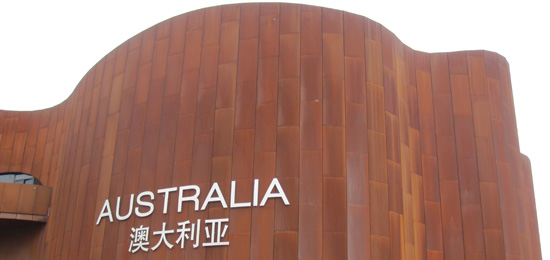 The 2010 World Exposition in Shanghai will be the first registered one in a developing country. Officially known as “Expo Shanghai 2010,” it will last 184 days and provide China an opportunity to show off its remarkable economic growth. The expo will also give foreign nations and companies a chance to further develop business partnerships with China and Chinese companies. This is the twelfth in an ongoing series that will look at the upcoming expo, from country pavilions to trade development. In this article, we take a look at the Australian Pavilion.
The 2010 World Exposition in Shanghai will be the first registered one in a developing country. Officially known as “Expo Shanghai 2010,” it will last 184 days and provide China an opportunity to show off its remarkable economic growth. The expo will also give foreign nations and companies a chance to further develop business partnerships with China and Chinese companies. This is the twelfth in an ongoing series that will look at the upcoming expo, from country pavilions to trade development. In this article, we take a look at the Australian Pavilion.
By Joe Drury
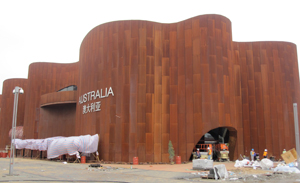 Mar. 15 – On March 9, members of the Shanghai’s Australian Chamber of Commerce’s business elite and local media were invited for an exclusive tour of the Australian pavilion led by Peter Sams, Pavilion Director. The event was designed to preview the unique experience seven million visitors over six months will enjoy traveling through the pavilion as well as business opportunities that will further solidify the relationship between Australia and China – now Australia’s largest trading partner.
Mar. 15 – On March 9, members of the Shanghai’s Australian Chamber of Commerce’s business elite and local media were invited for an exclusive tour of the Australian pavilion led by Peter Sams, Pavilion Director. The event was designed to preview the unique experience seven million visitors over six months will enjoy traveling through the pavilion as well as business opportunities that will further solidify the relationship between Australia and China – now Australia’s largest trading partner.
Pavilion officials interpreted the Shanghai official motto of “Better City, Better Life” through the pavilion theme of “Mastering the Challenges: Australia’s Smart Solutions for Our Urban Future.” By walking through three acts, titled “Journey,” “Discover,” and “Enjoy,” visitors will learn about Australian culture and the importance of innovative and sustainable urban planning.
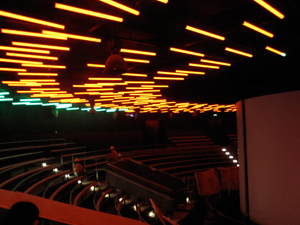 The design was selected from a pool of 12 proposals from Australian architecture firms. “It was very hard to choose, a very difficult decision,” explained Sams. “The final design had to answer the question: ‘who represents Australia?’ ”
The design was selected from a pool of 12 proposals from Australian architecture firms. “It was very hard to choose, a very difficult decision,” explained Sams. “The final design had to answer the question: ‘who represents Australia?’ ”
Australian architectural firm Wood Marsh together with design firm Think!OTS won approval with a unique concept combining dynamic design with natural imagery. The flowing exterior consists of a curving red-ochre wall that evokes sandstone visions of Australia’s outback and Ayer’s Rock. This wall is composed of a special type of weathering steel that reacts with Shanghai’s temperature and humidity, deepening its distinct color over time and adding an organic elegance to the structure.
The Australian experience begins in the three-story covered atrium that leads to the entrance of the pavilion voyage. Winding lit spirals of the official flower from Australia’s eight states and territories glow from within eight large mesh pods that hang from the ceiling. Dancers and aerial performers will entertain crowds waiting to commence their walk through the pavilion.
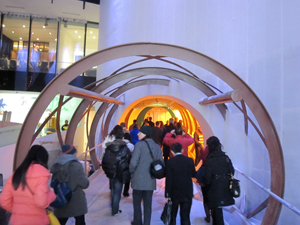 From here one enters the “Journey” section, a 160-meter enclosed ramp displaying five exhibitions that showcase Australian history. An important goal of the ramp is to keep people inside, out of the heat and discomfort of Shanghai’s muggy summers. But having an estimated 40,000 visitors per day passing through presented a logistical challenge.
From here one enters the “Journey” section, a 160-meter enclosed ramp displaying five exhibitions that showcase Australian history. An important goal of the ramp is to keep people inside, out of the heat and discomfort of Shanghai’s muggy summers. But having an estimated 40,000 visitors per day passing through presented a logistical challenge.
“The most important part of the pavilion is how to manage the crowd,” remarked Sams. “Our biggest goal was to not make people wait, so we did computer modeling for waiting and looking at exhibits, and tested it many times.” The pavilion’s designers predicted that 90 people would pass through the ramp every minute, so each of the five exhibits was crafted to present information in a time sensitive yet informative fashion.
Each exhibit gives visitors an understanding of the size and scope of Australia’s culture, from pre-colonial indigenous peoples to the diverse mosaic of present day society. Displays are accompanied by multi-lingual explanatory text on the opposite wall and music arranged by Dale Cornelius, a multi-award winning Australian composer who was also the head composer for Australia’s popular pavilion at Japan’s World Expo in 2005.
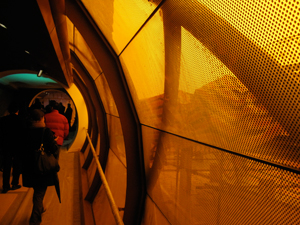 After passing through ‘Journey’ the tour shifts to ‘Discover’, which presents an advanced audio-visual show mixing animated and real images concerning the challenges and sustainable solutions of Australia’s rapidly urbanizing cities. The nine-minute show takes place in a 1,000 person capacity theatre-in-the-round, where a central revolving column of six high definition screens will be accompanied by overhead light displays and set pieces rising from the floor.
After passing through ‘Journey’ the tour shifts to ‘Discover’, which presents an advanced audio-visual show mixing animated and real images concerning the challenges and sustainable solutions of Australia’s rapidly urbanizing cities. The nine-minute show takes place in a 1,000 person capacity theatre-in-the-round, where a central revolving column of six high definition screens will be accompanied by overhead light displays and set pieces rising from the floor.
The final section guides visitors back to the atrium for ‘Enjoy’, which promotes Australian culture through retail shopping, Australian food and beverage, and continued opportunities to view the daily exhibitions by performers and artists.
The pavilion’s directors are well aware of the unique public diplomacy opportunities the Expo facilitates by providing direct contact between Australia and the Chinese public. Public diplomacy inherently “has a public message to it,” according to Sams. “Australia is here as Australia, not as the Australian government.”
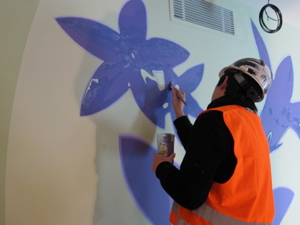 “The best thing about [the pavilion] is not the exhibitions, it’s the 250 plus staff. Over 4,000 people applied for these positions, one-half from Australia and one-half Chinese.” Added Sams, “China and Australia have a wide range of public diplomacy activities. The Expo is the biggest activity.”
“The best thing about [the pavilion] is not the exhibitions, it’s the 250 plus staff. Over 4,000 people applied for these positions, one-half from Australia and one-half Chinese.” Added Sams, “China and Australia have a wide range of public diplomacy activities. The Expo is the biggest activity.”
The two countries are increasingly linked by cultural exchange. In 2009 China surpassed New Zealand and Britain to become the largest source of migrants to Australia, and a half million Chinese tourists flood into the country every year. Not surprisingly, Chinese (Mandarin and Cantonese) is the second most spoken language in Australia, behind only English.
Equally important to the pavilion’s public diplomacy and exhibitions is the business program. Around 290 events are scheduled for special VIP areas on three floors, where 15,000 people will meet over the course of six months through trade and investment seminars, business networking events, and functions for corporate sponsors and stakeholders.
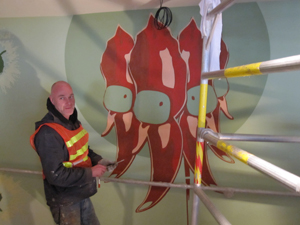 The spacious third floor VIP area overlooks the atrium through clear glass panels and can fit 84 people for dining or 120 people for cocktail events. In addition to open verandas, an on-site kitchen and presentation amenities such as drop down screens, the room will host a variety of musical performances through a resident musician program the pavilion established for Australian conservatory students.
The spacious third floor VIP area overlooks the atrium through clear glass panels and can fit 84 people for dining or 120 people for cocktail events. In addition to open verandas, an on-site kitchen and presentation amenities such as drop down screens, the room will host a variety of musical performances through a resident musician program the pavilion established for Australian conservatory students.
The second floor VIP space hosts a large boardroom and smaller meeting room, whereas the first floor VIP area is an open room lined with sculptures from each state and territory and will be used primarily for socializing. The three floors are meant to act in concert through a connecting elevator, so an event may start with a dinner and business presentation up on the third floor but proceed down to the first floor for drinks and conversation.
In its 2008-09 Commonwealth Budget, the Australian government pledged A$61 million (US$57 million) over a three-year period to fund its pavilion. An additional A$22 million (US$21 million) was raised through sponsorships with prominent Australian corporations such as ANZ Banking Group, BlueScope Steel and Rio Tinto, along with contributions from states and territories. The fund was the largest amount Australia has invested in any expo.
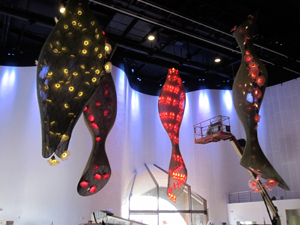 “The role of sponsors is to engage with employees in China and share the strengths of Australian business,” said Matthew Coghlan, VP of Finance for Bluescope Steel during an interview after the tour. “Bluescope is mostly a domestic company. We look at the Expo as an opportunity to give customers a better idea of Australia.”
“The role of sponsors is to engage with employees in China and share the strengths of Australian business,” said Matthew Coghlan, VP of Finance for Bluescope Steel during an interview after the tour. “Bluescope is mostly a domestic company. We look at the Expo as an opportunity to give customers a better idea of Australia.”
Australia’s significant public and private investment in the Shanghai Expo represents the booming economic relationship between these two Asia-Pacific nations, whose two-way trade, buoyed by Australia’s increased iron ore and coal exports, surged to A$76 billion (US$68 billion) over the year to last June.
In just the last 18 months China has injected US$40 billion worth of investments into the Australian economy, helping insulate it from some of the worst effects of the global financial crisis and staving off a recession.
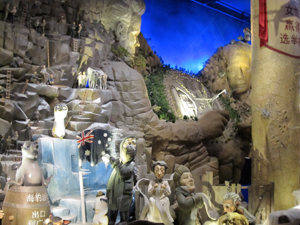 High profile leaders seem to recognize the importance of maintaining respect in light of cultural and economic ties. Chinese President Hu Jintao visited the Australian pavilion on Jan. 10 as part of his official inspection of the Expo site, the only international pavilion the president included in his tour.
High profile leaders seem to recognize the importance of maintaining respect in light of cultural and economic ties. Chinese President Hu Jintao visited the Australian pavilion on Jan. 10 as part of his official inspection of the Expo site, the only international pavilion the president included in his tour.
Shanghai AustCham reflects this closer economic dependency through its exponentially growing membership. According to AustCham Executive Director Kate Pollitt, their organization of 380-plus members is enjoying a 30 percent growth each year. Although the Australian government is the primary sponsor of the pavilion, the business program will give private organizations a means to directly make connections with Chinese counterparts and seek inroads to the lucrative Chinese market.
“There is a connection with government, but other businesses use different connections,” explained Pollitt after the tour. “The Expo will showcase that.”
A schedule of business events will be updated on the Australian Pavilion’s official website as the start of the Expo nears.
Further Reading
The Complete 2010 Shanghai Expo Series
- Previous Article Shanghai Expo 2010: The U.K. Pavilion
- Next Article Premier Wen Supports Balanced Trade









